“Am I just dreaming?” I honestly couldn’t tell as we sat around a beautifully set table on the terrace of the stunning Italian farmhouse overlooking the neat garden of herbs framing a lovely pool. Just beyond the pool was an olive grove with rolling Umbrian hills providing a remarkable backdrop. Sometimes experiences in life are so storybook perfect that it’s hard to discern if it really is true, or just a dream. This was the kind of thing I had read about in books or saw in movies… and yet here we were.
Krisztina had invited us for dinner. Krisztina was our Engel & Volkers real estate agent in Italy, but she was so much more. Very quickly, she became a good friend. Originally from Hungary, she had lived in Germany for years, then married an Italian man, Lucio. Together they make their home in the Umbrian countryside where Lucio runs an olive oil business and they manage their very popular vacation rental in one wing of their beautiful home.
I’ve rarely met an individual as multi-talented as Krisztina, excelling in so many ways. She’s a very successful real estate agent, and also a fabulous interior decorator. The farmhouse that Lucio and Krisztina completely renovated –perfect in literally every detail– is the kind of place you read about in magazines, and her absolutely stunning kitchen (“cucina”) is the place that professional cooks envy. She also speaks multiple languages– sometimes at the same time. When she brought her mother to see our house, she was speaking Hungarian to her, Italian to Lucio, and English to us, going back and forth between all of us within the same conversation. I’ve never heard anything like it!
Krisztina’s talent as a cook rivals the best you will find anywhere. I had no idea she was such a wonderful chef! In true Italian fashion, we sat around the table on the terrace as we talked, savoring– in the perfect sense of the word– plates piled high with fried zucchini blossoms, round balls of fresh burrata mozzarella topped with beads of tart vinegar, melon wedges wrapped in prosciutto, garden fresh tomatoes, olives, artichokes… And her homemade focaccia was so light, it was like nothing I’d ever tasted before. So incredibly delicious! This food, however, was just the antipasto. And it was our initiation into true Italian feasting.
After clearing the emptied plates, Krisztina returned again with big bowls of seafood pasta. And that’s when I first realized that having lived for so long in an “eat and run” American culture, I just couldn’t compete with the Italians in either time or quantity. To the Italians, eating is an art. Food is to be savored within the context of fellowship. It’s a way to reach the zenith of hospitality and truly enjoy life.
Italians cap their day off by eating late, and eating slowly. Restaurants in Italy don’t even open for dinner until 7 p.m. Not surprisingly, Dan and I are invariably the first ones to arrive into these empty spaces. They start to fill sometime closer to 8 p.m. and are at the apex of lively and animated conversation by the time we’re ready to leave.
The menus all characteristically begin with a variety of antipasto options, followed by the first course (“Primi”) which offers a variety of pastas or risotto. This is followed by “Secondi,” characteristically the meat courses, followed again by a separate variety of sides including vegetables and/or salad (“insalata.”) And of course, it ends with “Dolci,” dessert. And all of these courses are accompanied by wine. Still, the Italians don’t hurry off when the food is gone. After the meal, they linger over coffee. How I wish I could enjoy evening coffee without it keeping me awake all night!
The Italians order from each of the courses, and a relaxing dinner with conversation lingers for hours. This is a skill I am striving to learn. As it is, we just can’t eat as much– or as slowly– as they do, so Dan and I only order a single entree from the Primi course. Sometimes one of us will order a pasta dish from the Primi and the other will order meat from the Secondi, and we’ll share. Even the Italian pizzas are too big for us to eat by ourselves, so we share a pizza, but more often we’ll take home half for lunch the next day. A treasured memory is of sitting in an outdoor cafe in Naples with our two oldest grandkids experiencing a true Neapolitan pizza– Marguerita style. Pizza originated in Naples, vero?
Italian food is fresh, homemade, delicious, and plentiful. Considering that fact, we have rarely seen an overweight or unhealthy Italian. Food products are carefully regulated as pure– no additives, preservatives, artificial colors, or GMOs. Where gluten causes an arthritic inflammatory reaction for me in America, I have no problem eating the wheat in Italy. Consequently, I thrive in participating in the classic Italian breakfast– a cappuccino and a croissant (“cornetto”) at my favorite cafe. And by the way, it really is true that Italians won’t drink a cappuccino after 11 a.m. It’s strictly a ‘breakfast’ indulgence.
Clearly, walking is a regular part of life that contributes to better health in Europe. So much of it is uphill and down in these many ancient hilltop cities. Dan tracks an average of about 2-4 miles that we walk per day, and up to about 6+ miles if we’re in a large city, going from site to site.
There are more than 20 restaurants in Citta della Pieve, and not surprisingly the pizza in each place is different than the others, with characteristics common only to that particular place. Pizza, like the borsht of my heritage, is a “concept,” not a “recipe.” One has a chewy crust, while another rolls the crust so thin it’s like eating a gigantic cracker. Sauces vary, and many restaurants feature their own unique pizza specialties. The most authentic, of course, are the places like Serenella’s, where the local Italians go.
Food in all of these restaurants is so fresh and homemade, and comes right out of the oven. The restaurant Perugina makes their own absolutely delicious pistachio pesto, served over ravioli. Locanda della Picca features a creamy white (“bianca”) cheese sauce over ravioli. We can find Dan’s favorite pasta pretty much everywhere, but probably the best is at a place with the unlikely name of Dandy’s. The pasta is called “pici” (pronounced ‘peachy’), a thick hand-rolled type of spaghetti. Another favorite is the gnocchi at a tiny but amazing restaurant overlooking the valley, Bistrot Del Duca. Compared to American prices, eating out in Italy is considerably more affordable!
At Trattoria Bruno Coppetta, I ordered Cacio e Pepe, only to be pleasantly surprised that it involved tossing hot pasta in a gigantic wheel of pecorino cheese to coat it– like I had seen in videos. Unbelievably delicious!
Krisztina’s dinner was a wonderful initiation into Italian hospitality, but it was only the beginning. Since then, we’ve enjoyed many wonderful Italian dinners with friends from our church there, expats we’re getting to know, and neighbors– pastas, pesto, fresh wood-fired pizza made from scratch by our Italian pastor friend Giuseppe, pulled hot from the outdoor brick pizza oven on a classic wooden paddle…amazing!
Food is fellowship. Eating together is communication and communion. Sharing food is the ultimate expression of hospitality, and without a doubt, we’ve found that it’s an art the Italian people have perfected so beautifully. We strive to achieve it.
A few years ago, we sat around a long table in a nearby Umbrian hilltop city with family– our kids and their spouses– enthralled with abundant and delicious Italian food, wine, fellowship… and one of our sons suddenly commented, “This is what heaven will be like.” That moment froze in time for me. He was right. I’m absolutely sure that heaven will be like this.
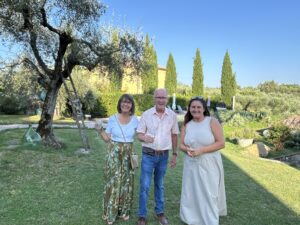
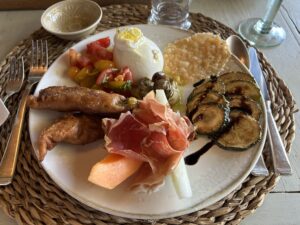
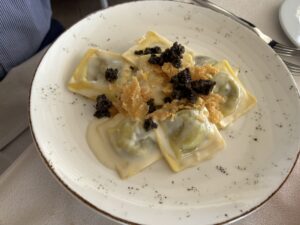
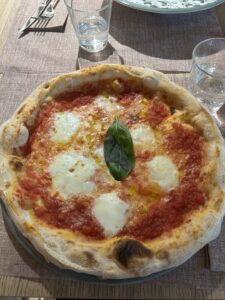

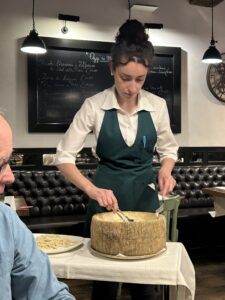
Once again, Susan, you have expressed it all so beautifully! And to think that we get to experience it a second time!